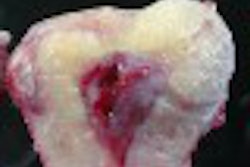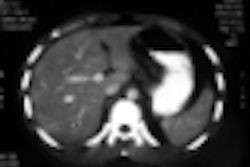The unusual ultrasound appearance of the uterus in women receiving tamoxifen citrate can be misinterpreted as endometrial thickening. This confusing appearance is due to microcystic change in the proximal myometrium of the uterus, according to a presentation at the 2001 International Society of Ultrasound in Obstetrics and Gynecology world congress in Melbourne, Australia.
"When viewed with saline infusion sonohysterography (SIS) these changes are often microcysts that represent dilated cystic atrophic glands, and can be located in the basalis of the endometrium and the proximal myometrium, or even within polyps," said Dr. Steven Goldstein, associate director of the gynecological ultrasound unit at New York University School of Medicine in New York City.
The roles of tamoxifen and raloxifene as part of a strategy to reduce the risk of breast cancer has been the source of some controversy.
According to published reports, "treatment with tamoxifen reduced the risk of tumor recurrence by 47% and reduced the death rate by 26%," Goldstein said. "The take-home message is that tamoxifen saves lives and tamoxifen prolongs lives." But tamoxifen has also been associated with an increased risk of endometrial cancer and thrombotic disease.
A Belgian study in 1990 was the first prospective study of the effects of tamoxifen on the endometrium. After 36 months of tamoxifen treatment, seven of the 16 postmenopausal women investigated developed endometrial proliferation including polyps and endometrial enocarcinoma (European Journal of Obstetrics and Reproduction, May-June, Vol. 35:2-3, pp. 235-238).
Research conducted at Goldstein’s institution showed that endometrial thickness of 5 mm or smaller had a 99% negative predictive value in women with postmenopausal bleeding.
"After the development of the transvaginal transducer, people began to publish on the use of transvaginal ultrasound in the use of postmenopausal patients with bleeding," Goldstein said. "An endometrial echo of 6 mm or more was associated with all pathology types imaginable."
They found a 27% incidence of polyp formation, 4% incidence of carcinoma, and a 9% incidence of either proliferation or hyperplasia. Twenty-five percent maintained a thin endometrial echo less than or equal to 5 mm. Less than 59% ultimately demonstrated inactive atrophic endometrium, and many required saline infusion sonohysteropgraphy to prove it, Goldstein explained.
SIS enables accurate measurements of endometrial thickness, Goldstein said. He recommended that if the central endometrial echoes were thickened, SIS should be performed.
If the tissue surrounding the saline is thin and symmetrical, and measures less than 3 mm (single-layer measurement), then the patient can be followed at appropriate intervals.
"But if the SIS shows abnormal endometrial findings such as polyps or thickening, then a hysteroscope is required to provide direct vision," he said.
Raloxifene, a second-generation selective estrogen receptor modulator, was recently given FDA approval for prevention of osteoporosis in postmenopausal women. Last year, Goldstein’s group prospectively studied the effect of raloxifene in 415 healthy postmenopausal women (47-60 years), all of whom had a baseline endometrial thickness of less than 5 mm. Transvaginal ultrasound was performed after three months of treatment and SIS was performed at six-month intervals (Obstetrics and Gynecology, July 2001, Vol. 98:1, pp. 91-96).
According to the results, for the group receiving unopposed estrogen, 39% developed proliferation, and 23% developed hyperplasia. In the group receiving raloxifene, no endometrial hyperplasia was demonstrated.
"Raloxifene, at 60 or 150 mg/day for one year, did not stimulate the postmenopausal endometrium. End-point endometrial thickness, morphology, and uterine volume in the raloxifene groups were similar to those observed at baseline and in the placebo group," according to Goldstein.
By Leanne McKnoultyAuntMinnie.com contributing writer
December 11, 2001
Leanne McKnoulty is an accredited medical sonographer currently lecturing in ultrasound at Monash University in Melbourne, Australia. She also is an editor at Ultrasound Review.
Related Reading
Endometrial screening unnecessary in women treated with tamoxifen, October 6, 2000
Ultrasonography effectively measures tamoxifen's effect on endometrium, October 12, 2000
Tamoxifen side effect calls for uterine-imaging protocol, January 24, 2000
Copyright © 2001 AuntMinnie.com



















